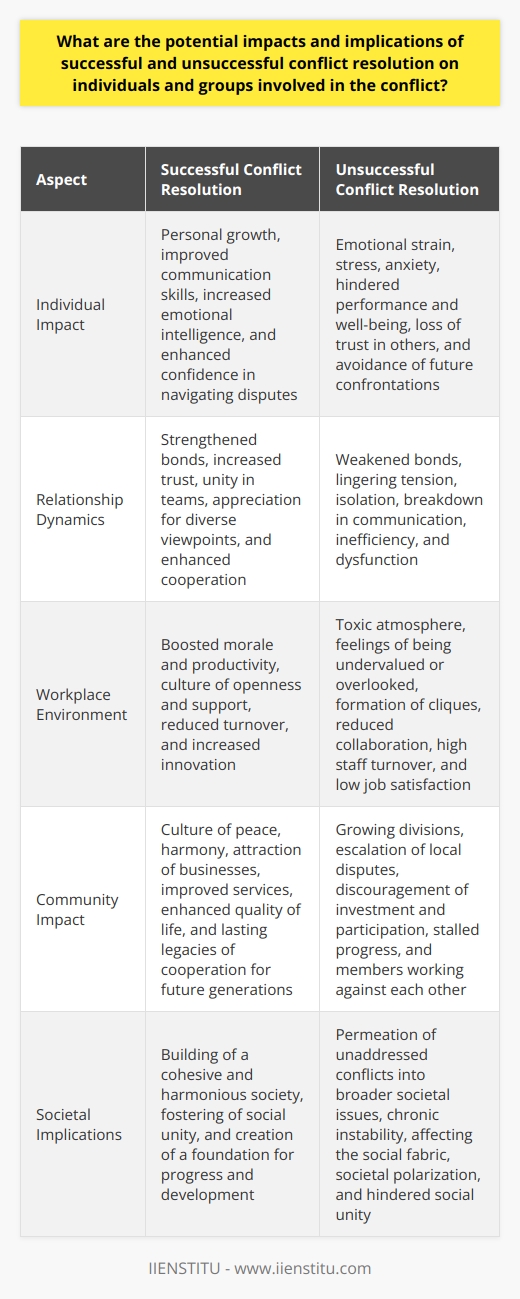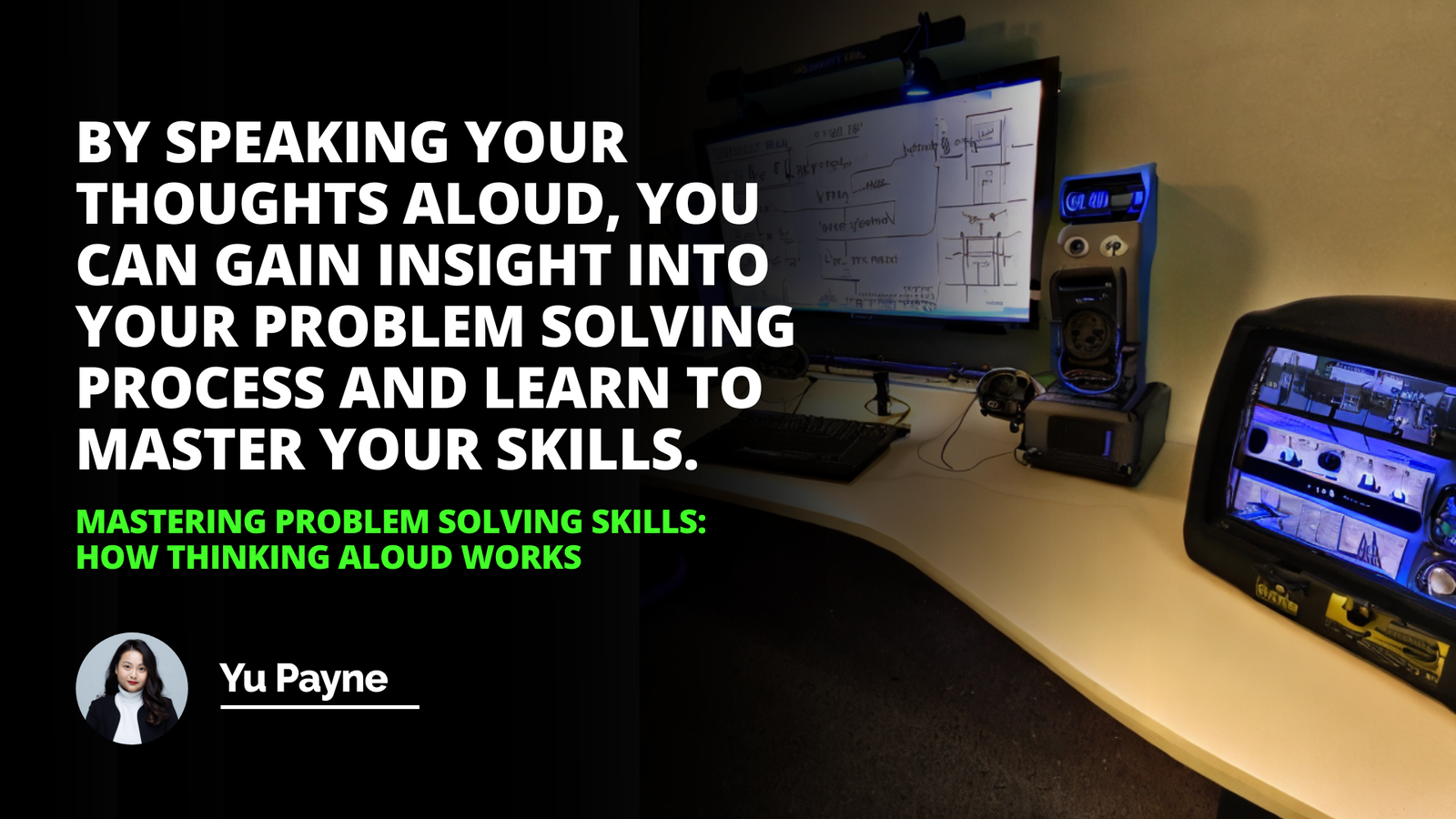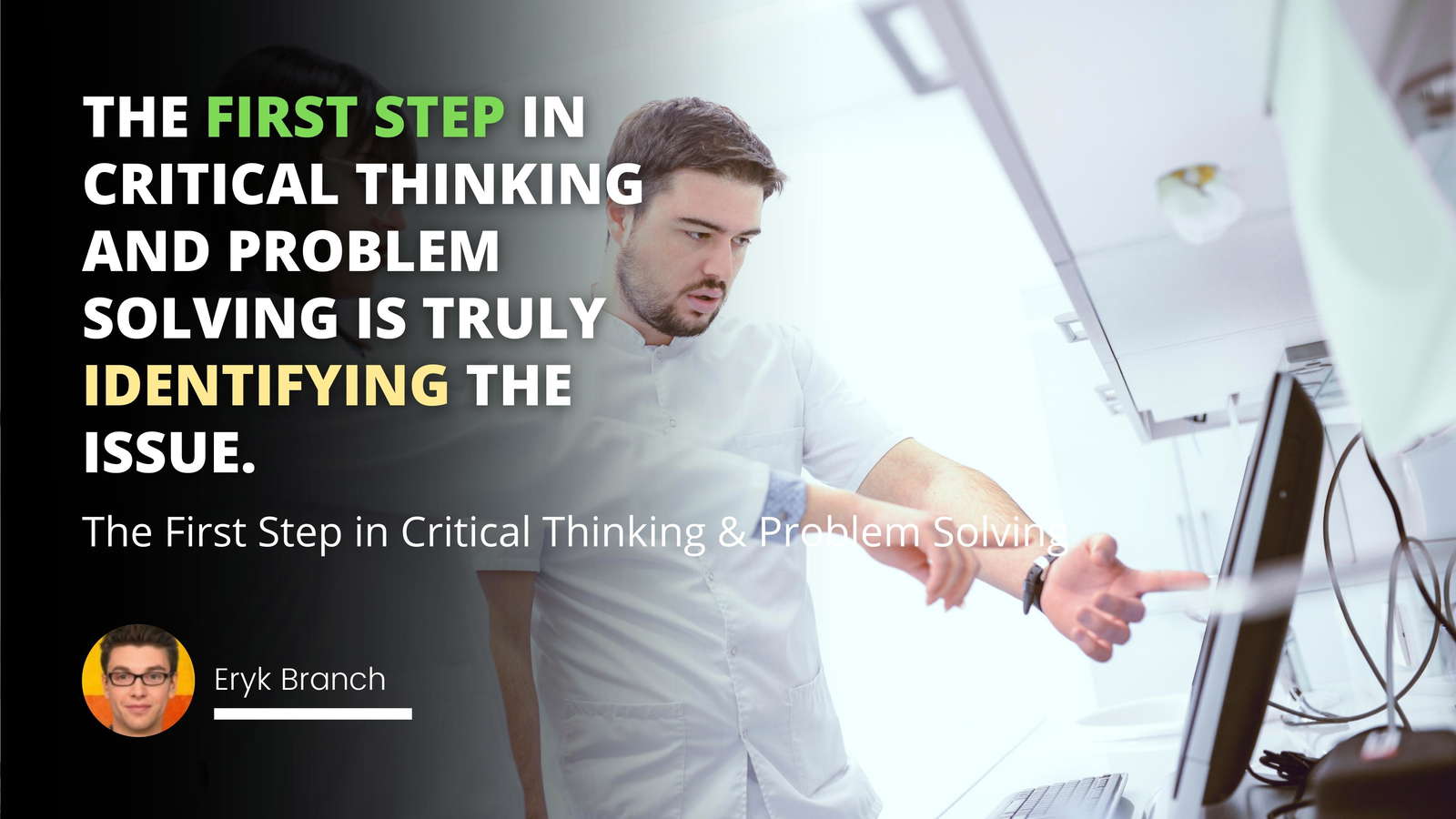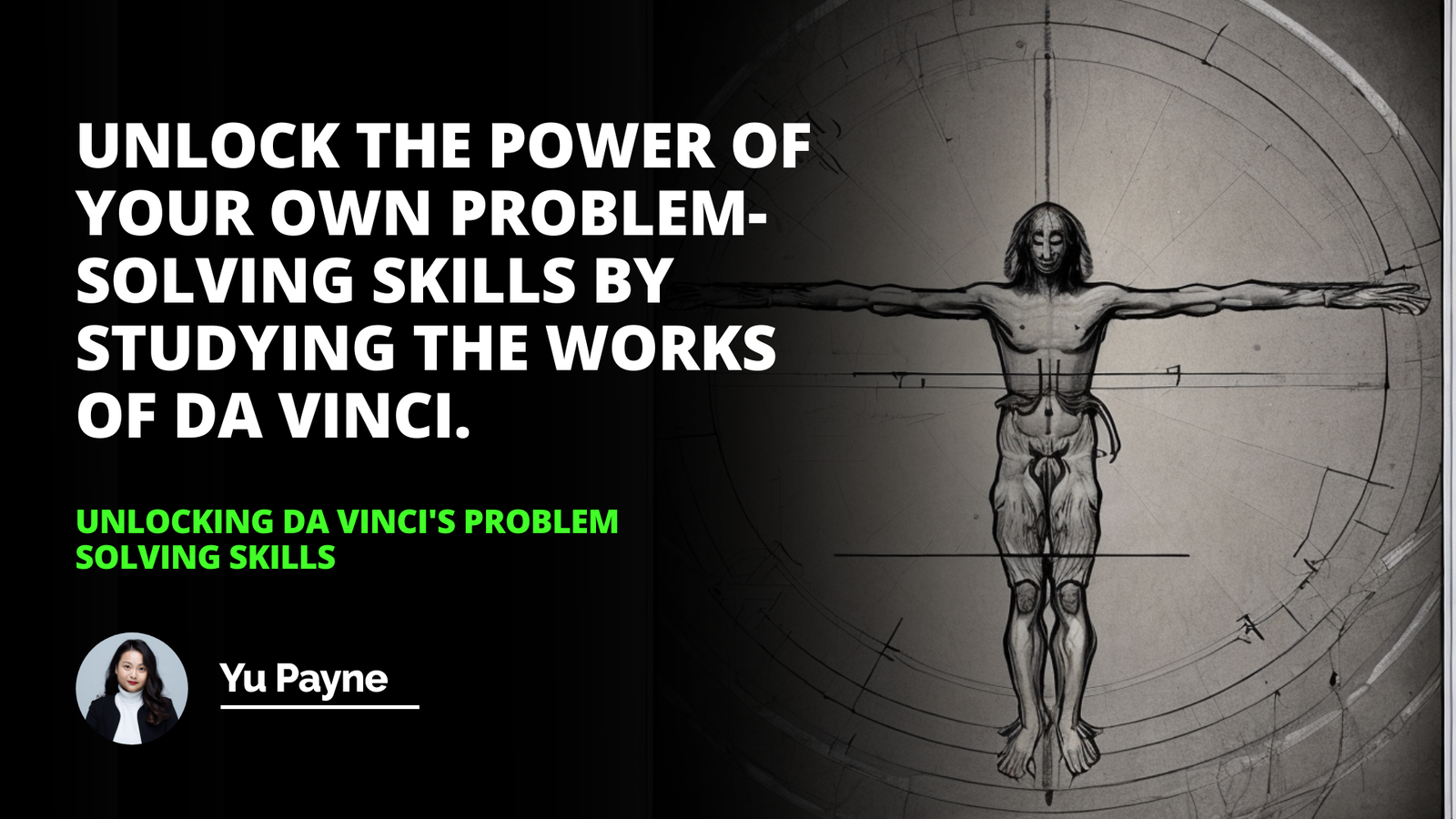
In this complex and fast-changing world, conflict is an inevitable part of life. From personal relationships to professional associations, disagreement and discord can arise, leading to a wealth of potential problems. Hence, mastering the art of conflict resolution is increasingly important in various aspects of life. Conflict resolution as an essential skill facilitates problem-solving, enhances interpersonal relationships, boosts team performance, and paves the way for personal growth and organizational success. This article aims to provide a comprehensive overview and examination of conflict resolution, its techniques and strategies, supported by practical examples. Particularly, problem-solving training courses and relevant online resources, including online conflict resolution training courses, will be explored to offer an insightful perspective on the topic.
Defining Conflict
Conflict is an intrinsic part of human interaction, often arising when differing interests, values, beliefs or needs collide. It can occur in numerous contexts, from family disagreements to workplace disputes. For instance, a couple may encounter a conflict over financial matters while team members in an organization might have a conflict over task allocation or project deadline. Understanding the true nature of conflict and recognizing its manifestation is the first step in effective conflict resolution.
Causes of Conflict
Conflict arises from various elements including individual differences, resource competition, miscommunication or misunderstanding. Personal beliefs, values and goals may clash resulting in internal discord. Likewise, limited resources can often instigate conflict as individuals or groups compete for their share. Miscommunication or misunderstanding can also breed conflict when information is misinterpreted or inadequate. For instance, a team leader's ambiguous instructions can trigger a dispute among team members about task responsibilities.
Negotiation
Negotiation is a commonly used conflict resolution method where parties engage in mutual discussion to find a solution. It involves several steps, starting from defining the problem, exchanging offers and counteroffers, to finally reaching an agreement. A simple example of negotiation could be a landlord and a tenant negotiating on the terms and conditions of a lease agreement.
Mediation
Mediation is another effective way of resolving disputes, wherein a neutral third party called a mediator facilitates communication between conflicting parties helping them reach a consensus. An example of mediation can be seen in a divorce settlement where a mediator assists in developing an amicable solution that is in the best interest of both parties.
Arbitration
Arbitration is a process where an impartial third party known as an arbitrator decides on the outcome of a conflict after listening to the arguments of the disputants. It is often used in legal and business conflicts, where the arbitrator's decision is legally binding. An example can be a business dispute over a contract that is settled by an arbitrator.
Collaboration
Collaboration occurs when parties involved in a conflict actively work together to find a resolution that satisfies all parties. It requires open communication, trust, and mutual respect. For instance, conflicts arising within a team regarding project assignments can be resolved through a collaborative approach, where team members openly express their viewpoints and work together to find an agreeable solution.
I remember a time when I was working on a group project in college, and we encountered a significant conflict. One team member was consistently failing to meet deadlines and contribute their fair share of the work. As tensions rose, it became clear that we needed to address the issue head-on. Drawing from the conflict resolution techniques I had learned in a communication course, I initiated a calm and open discussion with the team.
Importance of Communication
Effective communication plays a crucial role in conflict resolution. It's important to articulate thoughts clearly and listen attentively. Techniques to enhance communication skills include active listening, empathy, and nonverbal communication. Attending problem-solving training courses can be a useful way of refining these skills.
Emotional Intelligence
Emotional intelligence greatly impacts the ability to handle conflicts effectively. Awareness of own and other's emotions helps to manage responses in a way that deescalates potential conflicts. Online certificate courses often cover techniques and strategies to enhance emotional intelligence.
Active Listening
Active listening is another indispensable conflict resolution skill. It requires fully concentrating, understanding, responding and then remembering what is being said. Training courses can offer techniques to improve active listening skills, such as paraphrasing and reflecting, questioning, summarizing, and clarification.
Being Solution-focused
Focusing on solutions rather than problems can steer conflicts towards a constructive end. Solution-oriented thinking encourages cooperation and empathy among conflicting parties, fostering an environment conducive for reconciliation and agreement.
We started by clearly defining the problem at hand and allowing each team member to express their concerns and frustrations. By practicing active listening, we were able to better understand each other's perspectives and feelings. Through this process, we discovered that our struggling team member was dealing with personal issues that were impacting their ability to contribute effectively.
Together, we brainstormed potential solutions and found a way to redistribute tasks and provide additional support to ensure the project's success. By approaching the conflict with empathy, open communication, and a focus on finding a mutually beneficial solution, we were able to not only resolve the immediate issue but also strengthen our team's bond and overall performance.
This experience taught me the importance of developing effective conflict resolution strategies and applying them in real-world situations. It also highlighted the value of investing in personal development through courses and training programs that can equip individuals with the necessary skills to navigate complex interpersonal dynamics.
Understanding Conflict
----------------------
Defining Conflict
Conflict is an intrinsic part of human interaction, often arising when differing interests, values, beliefs, or needs collide. It can occur in numerous contexts, from family disagreements to workplace disputes. For instance, a couple may encounter a conflict over financial matters, while team members in an organization might have a conflict over task allocation or project deadlines. Understanding the true nature of conflict and recognizing its manifestation is the first step in effective conflict resolution.
According to Wilmot and Hocker (2017), conflict is defined as "an expressed struggle between at least two interdependent parties who perceive incompatible goals, scarce resources, and interference from others in achieving their goals" (p. 11). This definition highlights the key elements of conflict, including the presence of multiple parties, perceived incompatibility, and the potential for interference or competition.
Causes of Conflict
Conflict arises from various elements, including individual differences, resource competition, miscommunication, or misunderstanding. Personal beliefs, values, and goals may clash, resulting in internal discord. Likewise, limited resources can often instigate conflict as individuals or groups compete for their share. Miscommunication or misunderstanding can also breed conflict when information is misinterpreted or inadequate. For instance, a team leader's ambiguous instructions can trigger a dispute among team members about task responsibilities.
In their book "Interpersonal Conflict," Wilmot and Hocker (2017) identify five primary causes of conflict:
1- Relationship Conflicts: These arise from differences in personality, values, or communication styles.
2- Data Conflicts: These occur when parties have different information or interpret data differently.
3- Interest Conflicts: These happen when parties have competing needs or desires.
4- Structural Conflicts: These result from external factors such as resource scarcity or organizational constraints.
5- Value Conflicts: These emerge when parties have different beliefs or principles.
Understanding these underlying causes can help individuals and organizations better identify and address conflicts as they arise.
Conflict Resolution Methods
---------------------------
There are several approaches to resolving conflicts, each with its own merits and applications. Some of the most common methods include negotiation, mediation, arbitration, and collaboration.
Negotiation
Negotiation is a commonly used conflict resolution method where parties engage in mutual discussion to find a solution. It involves several steps, starting from defining the problem, exchanging offers and counteroffers, to finally reaching an agreement. A simple example of negotiation could be a landlord and a tenant negotiating on the terms and conditions of a lease agreement.
Fisher and Ury (2011), in their seminal work "Getting to Yes: Negotiating Agreement Without Giving In," outline four key principles for effective negotiation:
1- Separate the people from the problem
2- Focus on interests, not positions
3- Generate a variety of possibilities before deciding what to do
4- Insist that the result be based on some objective standard
By following these principles, parties can engage in more productive and mutually beneficial negotiations.
Mediation
Mediation is another effective way of resolving disputes, wherein a neutral third party called a mediator facilitates communication between conflicting parties, helping them reach a consensus. An example of mediation can be seen in a divorce settlement where a mediator assists in developing an amicable solution that is in the best interest of both parties.
According to Moore (2014), mediation is "an extension or elaboration of the negotiation process that involves the intervention of an acceptable third party who has limited or no authoritative decision-making power" (p. 15). The mediator's role is to guide the parties towards a mutually acceptable resolution by fostering open communication, clarifying misunderstandings, and exploring potential solutions.
Arbitration
Arbitration is a process where an impartial third party known as an arbitrator decides on the outcome of a conflict after listening to the arguments of the disputants. It is often used in legal and business conflicts, where the arbitrator's decision is legally binding. An example can be a business dispute over a contract that is settled by an arbitrator.
Elkouri and Elkouri (2016) define arbitration as "a simple proceeding voluntarily chosen by parties who want a dispute determined by an impartial judge of their own mutual selection, whose decision, based on the merits of the case, they agree in advance to accept as final and binding" (p. 1). Arbitration can be a faster and less formal alternative to litigation, providing a structured approach to conflict resolution.
Collaboration
Collaboration occurs when parties involved in a conflict actively work together to find a resolution that satisfies all parties. It requires open communication, trust, and mutual respect. For instance, conflicts arising within a team regarding project assignments can be resolved through a collaborative approach, where team members openly express their viewpoints and work together to find an agreeable solution.
Gray (1989) describes collaboration as "a process through which parties who see different aspects of a problem can constructively explore their differences and search for solutions that go beyond their own limited vision of what is possible" (p. 5). By fostering a collaborative environment and encouraging creative problem-solving, organizations can turn conflicts into opportunities for growth and innovation.
Developing Conflict Resolution Skills
-------------------------------------
To effectively resolve conflicts, individuals must develop a range of skills and competencies. Some of the most critical skills include communication, emotional intelligence, active listening, and solution-focused thinking.
Importance of Communication
Effective communication plays a crucial role in conflict resolution. It's important to articulate thoughts clearly and listen attentively. Techniques to enhance communication skills include active listening, empathy, and nonverbal communication. Attending communication skills workshops or enrolling in online conflict resolution training courses can be a useful way of refining these skills.
In their book "Crucial Conversations: Tools for Talking When Stakes Are High," Patterson, Grenny, McMillan, and Switzler (2012) emphasize the importance of creating a safe environment for open dialogue, focusing on shared goals, and using persuasive rather than abrasive language. By mastering these communication techniques, individuals can navigate difficult conversations and resolve conflicts more effectively.
Emotional Intelligence
Emotional intelligence greatly impacts the ability to handle conflicts effectively. Awareness of one's own and others' emotions helps to manage responses in a way that de-escalates potential conflicts. Many online conflict resolution training courses often cover techniques and strategies to enhance emotional intelligence.
Goleman (1995), in his book "Emotional Intelligence: Why It Can Matter More Than IQ," identifies five key components of emotional intelligence:
1- Self-awareness
2- Self-regulation
3- Motivation
4- Empathy
5- Social skills
By developing these competencies, individuals can better understand and manage their own emotions, as well as recognize and respond appropriately to the emotions of others, leading to more effective conflict resolution.
Active Listening
Active listening is another indispensable conflict resolution skill. It requires fully concentrating, understanding, responding, and then remembering what is being said. Training courses can offer techniques to improve active listening skills, such as paraphrasing and reflecting, questioning, summarizing, and clarification.
Paraphrasing involves restating the speaker's message in your own words to ensure understanding.
Reflecting involves acknowledging the speaker's feelings and emotions.
Questioning helps to gather additional information and clarify ambiguities.
Summarizing involves synthesizing the main points of the conversation.
Clarification seeks to clear up any confusion or misinterpretation.
By employing these active listening techniques, individuals can demonstrate empathy, build trust, and foster more productive dialogue during conflict resolution.
Being Solution-Focused
Focusing on solutions rather than problems can steer conflicts towards a constructive end. Solution-oriented thinking encourages cooperation and empathy among conflicting parties, fostering an environment conducive to reconciliation and agreement.
1- Identify the desired outcome or goal
2- Brainstorm potential solutions
3- Evaluate the feasibility and consequences of each solution
4- Select the most promising solution
5- Implement and monitor the chosen solution
By adopting a solution-focused approach, individuals and teams can move beyond the immediate conflict and work collaboratively towards a mutually beneficial resolution.
Conclusion
----------
In sum, understanding and adopting a variety of conflict resolution techniques and strategies can vastly improve interpersonal relationships, team dynamics, and overall productivity. Given the growing complexity of human interactions, embedding these strategies into everyday life and professional conduct can make us more capable of turning conflicts into opportunities for growth and understanding.
Investing in personal development through online conflict resolution training courses, workshops, and self-study can equip individuals with the necessary skills to navigate the challenges of conflict effectively. By cultivating strong communication skills, emotional intelligence, active listening, and solution-oriented thinking, we can foster more harmonious and productive relationships in both our personal and professional lives.
As the world continues to evolve and present new challenges, the ability to resolve conflicts constructively will remain an essential skill for success. By embracing the principles and strategies outlined in this article, we can not only mitigate the negative impact of conflict but also harness its potential for positive change and growth.
References
----------
Elkouri, F., & Elkouri, E. (2016). How arbitration works (8th ed.). Bloomberg BNA.
Fisher, R., & Ury, W. (2011). Getting to yes: Negotiating agreement without giving in (3rd ed.). Penguin Books.
Goleman, D. (1995). Emotional intelligence: Why it can matter more than IQ. Bantam Books.
Gray, B. (1989). Collaborating: Finding common ground for multiparty problems. Jossey-Bass.
Moore, C. W. (2014). The mediation process: Practical strategies for resolving conflict (4th ed.). Jossey-Bass.
Patterson, K., Grenny, J., McMillan, R., & Switzler, A. (2012). Crucial conversations: Tools for talking when stakes are high (2nd ed.). McGraw-Hill.
Wilmot, W. W., & Hocker, J. L. (2017). Interpersonal conflict (10th ed.). McGraw-Hill Education.
Frequently Asked Questions
What factors contribute to the escalation and deescalation of conflict?
Factors Contributing to Conflict Escalation
Communication Breakdown
Clear communication serves as the backbone of mutual understanding. Its absence can quickly escalate conflicts. Misunderstandings thrive where information lacks clarity. Assumptions replace actual facts. Parties misinterpret silence or non-responsiveness. This fuels mistrust. Miscommunication can spiral into overt conflict.
Power Imbalances
Conflict often grows from power disparities. Weaker parties may feel oppressed. Dominant parties might exploit power. This dynamic creates a breeding ground for escalating tensions. Fair dialogue becomes nearly impossible. Resentment and aggression flourish.
Unmet Needs
All individuals have basic needs. They stem from physical and emotional sources. Conflicts arise when parties neglect these needs. Ignored necessities lead to frustration. Unaddressed needs escalate matters. People become desperate to fulfill them.
Differing Values
Discrepancies in core values can divide individuals. Diverse beliefs challenge perspectives. Clashes ensue from these differences. Reconciliation proves difficult. Misaligned values deepen the divide. They intensify the conflict.
External Stressors
External factors can heighten conflict. They include economic pressures and social changes. Stress can exacerbate existing tensions. It acts as a magnifier of disputes. External pressures can push conflicts to the brink.
Factors Contributing to Conflict De-escalation
Effective Communication
Clear, open dialogue reduces misunderstandings. It builds the foundation for resolution. Both parties need to engage actively. Active listening becomes crucial. It allows viewpoints to converge.
Power Equality
Balanced power dynamics promote fairness. Equity eases the tension. It fosters an environment for peaceful interactions. All voices gain equal weight. Conflicts de-escalate as a result.
Addressing Needs
Acknowledging and addressing basic needs is imperative. It validates individual concerns. Solutions that meet these needs can emerge. Satisfaction of needs reduces conflict levels.
Value Recognition
Appreciating diverse values is essential. It allows empathy to surface. Mutual respect diminishes tension. Parties begin to coexist despite differences. It helps in mitigating conflicts.
Stressor Management
Managing external stress can alleviate conflict. It requires a proactive approach. Reducing pressure can lower confrontations. It shields conflicts from outside influence. Calm prevails over chaos.
In summary, conflicts escalate and de-escalate for various reasons. Both processes hinge on human behavior and interaction. Proper understanding and strategies can shift the direction. Awareness of these factors is critical. It enables better conflict resolution.
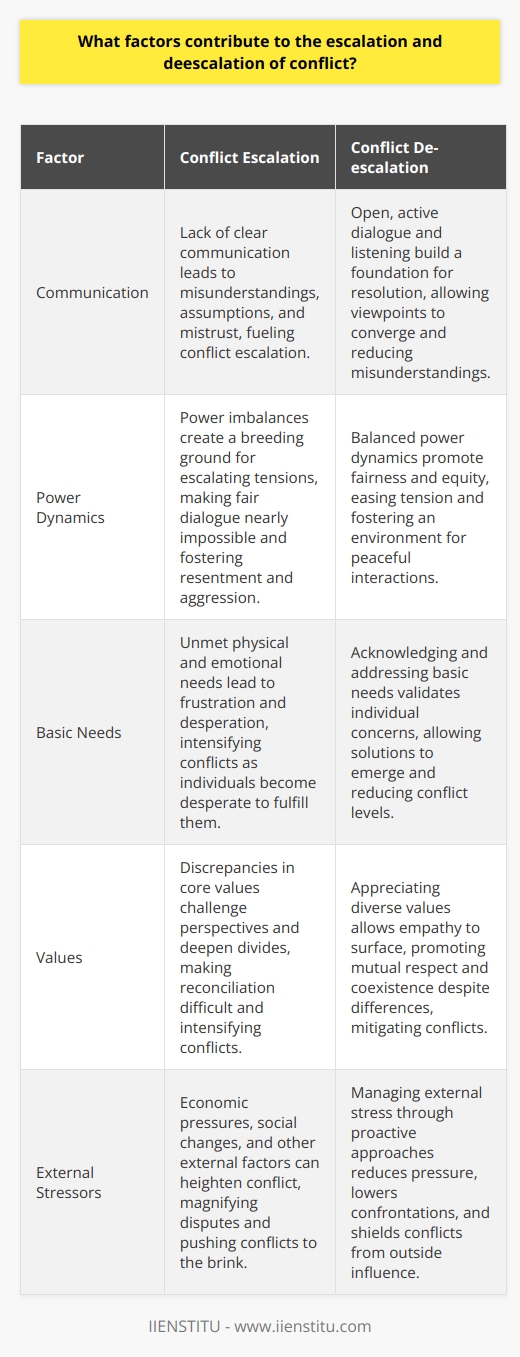
How does the application of various conflict resolution strategies vary depending on the nature and context of the conflict?
Understanding Conflict Resolution
Conflict resolution encompasses a range of strategies. Experts often tailor these strategies to specific situations. The nature and context of a conflict influence strategy choice greatly.
Nature of Conflict
The conflict's nature refers to its characteristics. Is it interpersonal, intrapersonal, organizational, or international? Each type demands different approaches.
Interpersonal conflicts often require communication-focused strategies. Such conflicts emerge between individuals. Thus, we focus on dialogue. Techniques like active listening become central.
Intrapersonal conflicts happen within an individual. Self-reflection methods prove effective here. Mental health professionals may guide through cognitive-behavioral techniques.
Organizational conflicts surface in workplaces or institutions. Here, mediation and negotiation are key. Formal dispute resolution mechanisms may apply.
International conflicts involve nations or large groups. Diplomacy and international law play significant roles. Such conflicts often need third-party intervention.
Context of Conflict
Context refers to the environment surrounding the conflict. It includes cultural, social, and economic backgrounds.
Cultural contexts influence norms and values. In such settings, understanding cultural practices is vital. Sometimes, conflicts require culturally-sensitive approaches.
Social contexts look at relationship dynamics. Social power structures can influence strategy. Often, community-based methods work best here.
Economic contexts involve resource-related conflicts. Here, fair distribution methods may be necessary. Arbitration can ensure impartial outcomes.
Key Strategies
Different strategies exist for a reason. They fit different scenarios.
- Negotiation involves direct discussions. It often serves in reciprocal relationships.
- Mediation introduces a neutral third party. It's useful for more ingrained conflicts.
- Arbitration involves a third-party decision-maker. This method works when parties need a binding resolution.
- Dialogue and Communication focus on understanding. They foster empathy and connection in interpersonal clashes.
- Collaborative problem-solving centers on finding a win-win. It's best when parties will continue interacting.
Implementing Strategies Effectively
Success depends on proper strategy application. One must understand the conflict's nature and context fully. Often, a blend of strategies is necessary. Each situation requires a unique mix.
Tailoring strategies to specific conflicts is an art. Skilled conflict resolution practitioners excel in this. They adapt their approach as needed. They consider all aspects of the conflict.
Conflicts are complex. Their resolution is equally complex. The application of various strategies varies widely. Each conflict is unique. Thus, the response requires customization. Knowledge of the nature and context shapes effective resolution tactics. An academic approach to conflict resolution values this adaptation. It does not seek one-size-fits-all solutions. Instead, it promotes nuanced and thoughtful application. Proper understanding leads to peaceful outcomes.
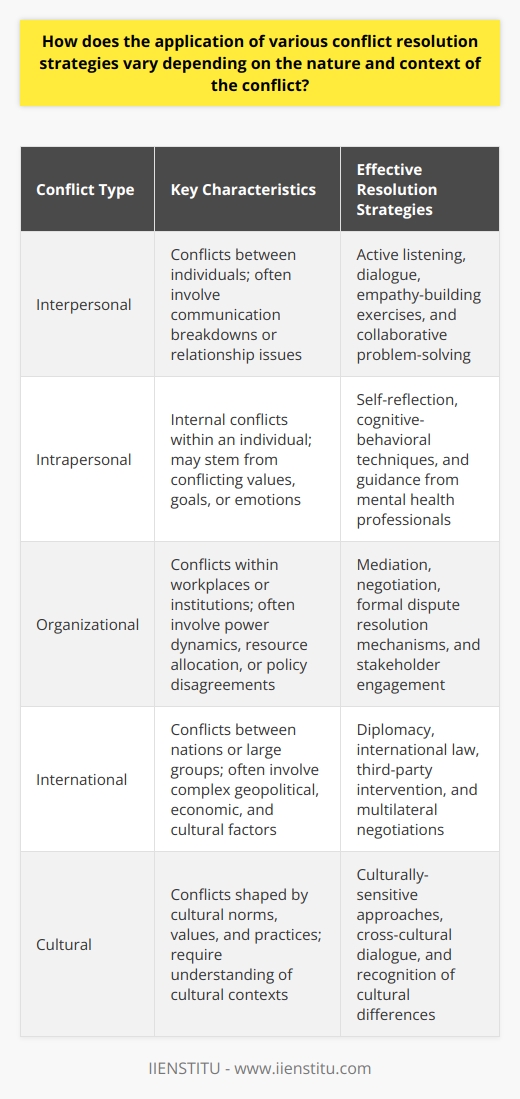
What are the potential impacts and implications of successful and unsuccessful conflict resolution on individuals and groups involved in the conflict?
Successful Conflict Resolution: Implications and Impacts
When parties resolve conflicts effectively, the outcomes can transform relationships and environments.
Individual Growth
Successful conflict resolution often leads to personal development. Individuals learn to communicate better, increasing their emotional intelligence. This learning turns disagreements into growth opportunities. With each success, people's confidence in navigating disputes grows.
Strengthened Relationships
Groups that overcome disagreements collectively often experience strengthened bonds. Trust proliferates with the understanding that differences don't equate to division. Unity in teams improves as members value each other's viewpoints. Cooperation thrives, making collective goals easier to achieve.
Positive Workplaces
In professional settings, successful resolution boosts morale and productivity. Employees feel heard and respected. This fosters a culture of openness and support. Companies see reduced turnover and increased innovation when conflicts resolve positively.
Healthy Communities
Communities also reap benefits. Members that resolve conflicts contribute to a culture of peace. This harmony attracts businesses, improves services, and enhances quality of life. Lasting resolutions create legacies of cooperation for future generations.
Unsuccessful Conflict Resolution: Implications and Impacts
Unsuccessful conflict resolution, however, can have the opposite effects.
Emotional Strain
Individuals facing unresolved conflicts often experience stress and anxiety. These intense emotions hinder their performance and well-being. People may lose trust in others and avoid future confrontations.
Damaged Relationships
Groups with unresolved disputes can suffer from lingering tension. Bonds may weaken, causing isolation. Communication within the group may break down, leading to inefficiency and dysfunction.
Toxic Work Environments
Workplaces without conflict resolution mechanisms often face toxicity. Employees might feel undervalued or overlooked. Cliques form, and collaboration suffers. Such environments can lead to high staff turnover and low job satisfaction.
Fractured Communities
Communities that fail to manage conflicts may see divisions grow. Local disputes can escalate, discouraging investment and participation. Progress stalls as community members work against rather than with each other.
Wider Societal Issues
Unaddressed conflicts can even permeate into broader societal issues. They can become sources of chronic instability, affecting the social fabric. Long-term disputes can lead to societal polarization and hinder social unity.
Successful conflict resolution builds; unsuccessful dismantles.
The two paths showcase the profound effects that conflict outcomes have on individuals, groups, and society. Thus, honing conflict resolution skills becomes not merely a personal benefit but a societal imperative.
